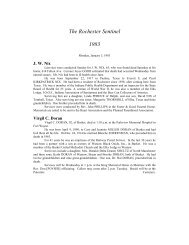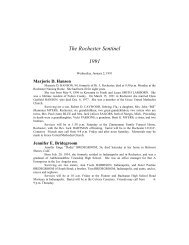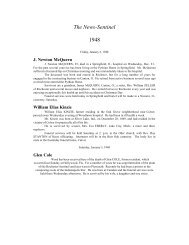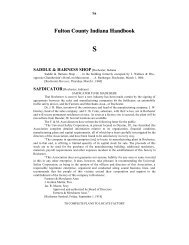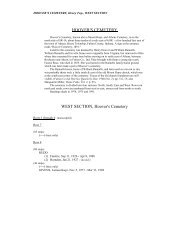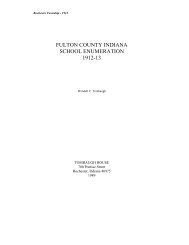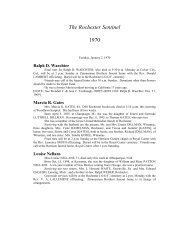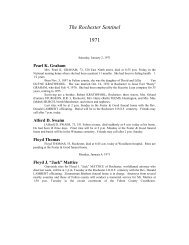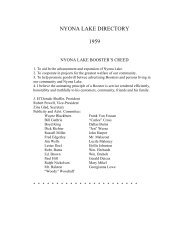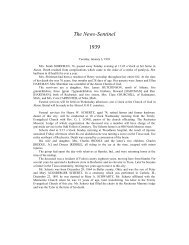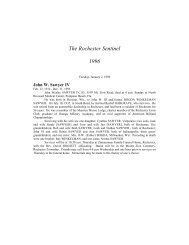Handbook N-P - Fulton County Public Library
Handbook N-P - Fulton County Public Library
Handbook N-P - Fulton County Public Library
Create successful ePaper yourself
Turn your PDF publications into a flip-book with our unique Google optimized e-Paper software.
Po<br />
establishment of the Indian mill that was built in accordance with the treaty with the<br />
Pottawatomies to grind the corn that they should bring to the mill. For years, this mill was a<br />
landmark of <strong>Fulton</strong> <strong>County</strong>. In 1835, a saw mill was built just below the Indian Mill on Mill Creek<br />
and in the following year a grist mill was attached to the saw mill. In 1840 the “Old Flouring Mill”<br />
was built. It was a two stone plant and was run by a spiral water wheel, a type that was very<br />
popular at that time. This mill was remodeled in 1846, an overshot wheel being substituted for the<br />
other. In the fall of 1858, the Pottawatomie Mills were built on land adjoining this mill and for<br />
many years this was one of the most flourishing businesses in the county. The mills fell into disuse<br />
for several years, but in 1875, they were remodeled and cunducted successfully until they were<br />
destroyed by fire in the nineties.<br />
[Henry A. Barnhart, An Account of <strong>Fulton</strong> <strong>County</strong> From its Organization , Dayton<br />
Historical Publishing Co., 1922 - Indexed and Reprinted by Wendell C. Tombaugh, 1981]<br />
__________<br />
WATER MILL IN ASHES<br />
Just after midnight, Wednesday morning a train crew on the C. & C. discovered a bright<br />
light in the second story of the Pottawatomie flour mills, at the north end of Main street, and their<br />
engine screamed a signal of distress. This attracted the attention of the electric light crew and they<br />
too saw the flames and pulled their steamboat whistle wide open. This soon aroused the town and<br />
the fire company was rushing pell mell to the fire.<br />
By the time the hose carts arrived the flames were all through the second, third and fourth<br />
stories and far beyond control. But the “laddies” turned the streams on and tried to save the engine<br />
house, located near the mill and the C. & E. bridge and pump station, but the heat became so<br />
intense the firemen were driven back, and mill, enginehouse and pump station all went up<br />
together, the railroad bridge being saved by liberal dashes of water. The heat was something<br />
frightful and houses in the vicinity were so hot it seemed they surely would take fire, but they<br />
were carefully guarded and none were damaged.<br />
In a talk with Mr. W. J. Leiter, of Leiter & Petersen, owners of the mill, we learn that<br />
there was about ten thousand bushels of wheat in the mill, fully seven thousand of which was<br />
stored and nearly all uninsured. Besides this there were two car loads of middlings stored in the<br />
mill ready for spring delivery and considerable custom wheat and chop feed. The firm carried<br />
$10,000 insurance on the mill and machinery and $3,000 on stock, which is scarcely half the value<br />
of the mill and its contents.<br />
The Pottawatomie mill was built 37 years ago, and was the most extensive flour mill in<br />
all this section of the country. The history of <strong>Fulton</strong> county says “Hamilton & Taber and Anthony<br />
F. Smith, in 1857, commenced preparations for the erection of a mill in Rochester on a more<br />
estensive scale than had ever before been attempted in this section of the state. The land for the<br />
site, the mill race and dam and the building and machinery cost $30,000 and the new mill was<br />
named the “Pottawatomie.” The investment, however, was not a profitable one, and the doors were<br />
locked and the mill stood idle for several years until W. J. Leiter and Clark Hickman purchased<br />
the property in 1875, and remodeled it and opened it for business.” They did a successful business<br />
for about twelve years, when Fred W. Petersen purchased Mr. Hickman’s interest, and three years<br />
ago the mill was again refitted with new process machinery thoughout, and did a large business.<br />
The firm has not yet decided what they will do, but it is likely another mill will be built<br />
on the site as the water power is very valuable.<br />
[Rochester Sentinel, Friday, February 15, 1895]<br />
POTTOWATTAMIE MILLS [Rochester, Indiana]<br />
[See LAKE MANITOU, LAKE MANITOU’S EARLY HISTORY - Rochester Sentinel,<br />
Saturday, March 11, 1922]<br />
Flouring mills, built in 1858, located at SE corner of Erie RR and Main.




